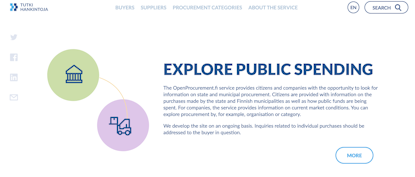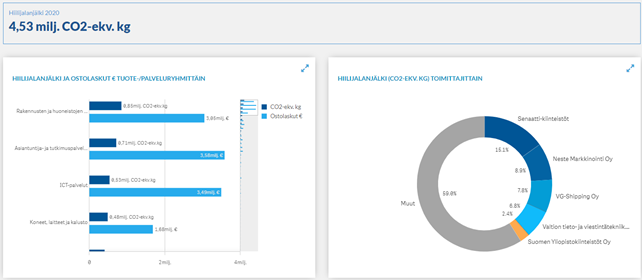Finland’s Hansel creates a digital trail of state spending

Challenge: Prior to 2017, Finland had no publicly accessible, centralized data on public procurement.
Approach: Inspired by Ukraine’s Prozorro open contracting reforms, Finland’s central procurement unit, Hansel, worked to aggregate invoicing data related to procurement and built a public open data portal so that everyone could analyze the central government’s public spending. The same data-driven approach is now used by civil servants to track sustainability and other performance metrics for procurement.
Results: Internal efficiency has increased and overpricing and inefficient purchasing practices are more easily identified. Journalists use the platform for holding authorities to account, including for some high-profile investigations into conflicts of interest. Companies find the service helpful for market research. Civil servants refer to it to compare prices and identify potential savings.
In September 2017, the online tool, Tutki Hankintoja – meaning “Explore state spending” – was launched at www.open procurement.fi. Since then, it’s been giving the public a glimpse into what the Finnish government is buying, with the aim of increasing transparency and accountability in the public sector.
The platform is a bit like looking at the transaction history of your online bank account, but instead of your own spending, it shows daily purchases made with taxpayers’ money by every central agency of the Finnish government, as well as those of some municipalities. The data, which is sourced from Finland’s bookkeeping system, is updated in almost real-time.
Users can search the purchases of more than 70 government buyers and around 20,000 suppliers each year from 2016 to the present. They can see details such as the procurement category, date and price of every invoice, and conduct simple analyses. The purchases total around €4 billion annually, and bulk downloads are available in various formats through Finland’s open data directory.
Despite being recognized as a leader in e-government and digital governance, Finland didn’t disclose open data on public procurement before 2017. Information related to public procurement had to be painfully requested from agencies one-by-one.
Now anyone can check procurement spending on demand through Tutki Hankintoja. Journalists in particular find the platform useful for holding authorities to account, with the Finnish Association of Investigative Journalism recognizing it with an award in April 2023 for “promoting openness” and contributing to award-winning investigative reporting.
Companies also use the service for market research, and civil servants refer to it to compare prices and identify potential savings. Because Finland uses an e-invoicing system, the accuracy of the data is very high.
The project began in 2016. Hansel – a non-profit limited company that acts as a central purchasing body for the public administration in Finland – was tasked with “improving the utilization of the procurement information base”. First and foremost, this job was about cataloging and collecting the data to improve the knowledge of the procurement units themselves, says Kirsi Koivusaari, Hansel’s Chief Financial Officer. Hansel used the data and identified some key performance indicators for regular analysis, and the project was championed by the Ministry of Finance.

But they didn’t stop at building a basic tool for civil servants that merely complied with state regulations. According to Koivusaari, the Hansel team were inspired by ideas at the International Open Data Conference in Madrid in October 2016, especially Ukraine’s award-winning Prozorro open contracting reforms, and set out to do something similar in Finland. They secured the Finance Ministry’s support and used open data standards to assemble, standardize and share Finland’s central government spending.
Finland also committed to creating an open, user-friendly public portal to share and analyze public procurement data in their 2017 Open Government Partnership action plan with Hansel as the lead.
At the same time, they promoted a culture of data use and analysis among public procurement professionals.
In September 2017, the new public platform went live. A few months later, the non-profit Open Knowledge Finland recognized the project with a “Heart of Openness” award, praising it as “a fine cooperation project, based on an inspiring vision and a will to include the openness of procurement information in legislation.”
From reactive to proactive transparency
Getting the data initially wasn’t as easy as one might think. At the time the service was developed, Hansel‘s legal rights to the data were unclear. By law, all public expenditure in Finland should be made public unless classified as secret, but no one had ever linked up all the procurement data and published it before. Indeed, some agencies vehemently opposed the idea. This was one of the biggest challenges to their project, according to Koivusaari.
“The most difficult part was not the technical development, but the negotiations with the units. The problem was, who owns the data? Everybody said, this is my data and you’re not allowed to make decisions over my data. So the Ministry of Finance wrote a letter to support the process.”
Finally, the defense sector, the border authorities and the police were excluded but almost anything else was published. And the law governing Hansel Ltd was amended in 2019 to formally give it the right to access and process procurement information, a big win.
The other big question was which technology to use. When Hansel first set out to gather the information for the original service for civil servants, the data fed into the internal business intelligence system. The same solution is also used in Ukraine to run the powerful procurement business intelligence system Prozorro, and Hansel had hoped to continue using it for the public platform they were developing.
But they found the licensing costs prohibitive so they decided to make an easy-to-use service that focused on the part of the procurement cycle they had the best data for: the invoices. This product was ordered from a small Finnish company Great Apes, whose motto is “big data requires data monkeys”.
Results
Openprocurement.fi, Finland’s public procurement data portal, accelerated an open contracting culture and accountability in Finland.
The project’s goal was to increase transparency, but it also highlighted potential savings. For example, one ministry’s stationery costs were 1000 times more than another. The Tutkihankintoja.fi service was also one of the data sources for research commissioned by the Ministry of Finance into the true value of public procurement spending annually in Finland, including small procurements and procurements made by public entities from each other. Its estimate was €47 billion in 2018 compared to a previous estimate by the EU Commission of €35 billion in 2015.
“Suddenly agencies were able to see each other’s spending. Some had lots of invoices over small amounts, which is not intelligent procurement,” Koivusaari says and which led to better planning for the future.
Investigative reporters have made good use of the Tutkihankintoja open data platform, scrutinizing issues such as ICT procurement and migration.
“The journalists love it and would complain if we stopped the service,” Koivusaari says.
Data from the openprocurement.fi platform has led to various high-profile investigations in Finnish media, including a scandal over a €50,000 media training contract that cost the then finance minister her job because it was perceived that she used the services for personal gain. Another popular investigation highlighted the surprising amount spent on alcohol by the President’s office (almost a quarter of the government’s total spending on drinks in 2017).
What’s next
The original internal system Hansel developed to track key indicators has evolved into a tool called Hankintapulssi (Procurement Pulse). It has dashboards that civil servants from 650 procuring units can use to monitor their performance through metrics that include sustainability and competition. For example, the system measures which product and service groups cause the most climate emissions, using a model developed by the Finnish Environment Institute in 2020.

Another example, looking at Hansel’s own procurement, the internal Hankintapulssi portal shows that Hansel signed almost 1200 contracts in 2021 and several new dynamic purchasing systems led to a significant increase in suppliers, to 872 up from 624 the previous year. The share of small and medium-sized suppliers was 51%, which was 14% of the value of joint procurement sales.
Koivusaari’s ultimate goal would be to see open data for the whole public procurement chain, from planning to award. “This is easy to do in practice. It just needs to be implemented,” says Koivusaari. A key consideration for her is to make the case for more funding to achieve that objective.
Koivusaari would like to see the open procurement ecosystem to grow, and for more municipal data to be included on Tutkihankintoja. The establishment of new agencies in the healthcare and social services sectors – which will open offices in 20 geographic regions of Finland – could be an opportunity, says Koivusaari. The agencies have no procurement history and could launch with an open procurement culture. “I want us to be very close to those new entities and be able to help them,” Koivusaari adds.
Finland’s procurement reforms have attracted the neighbors’ attention. Denmark is set to publish its own guidelines for procurement reform and Swedish counterparts have been in touch with Koivusaari to ask for advice. Data will continue to play a key role defining better processes – and to ensure citizens can keep tabs on public officials and make sure their taxes are spent appropriately.